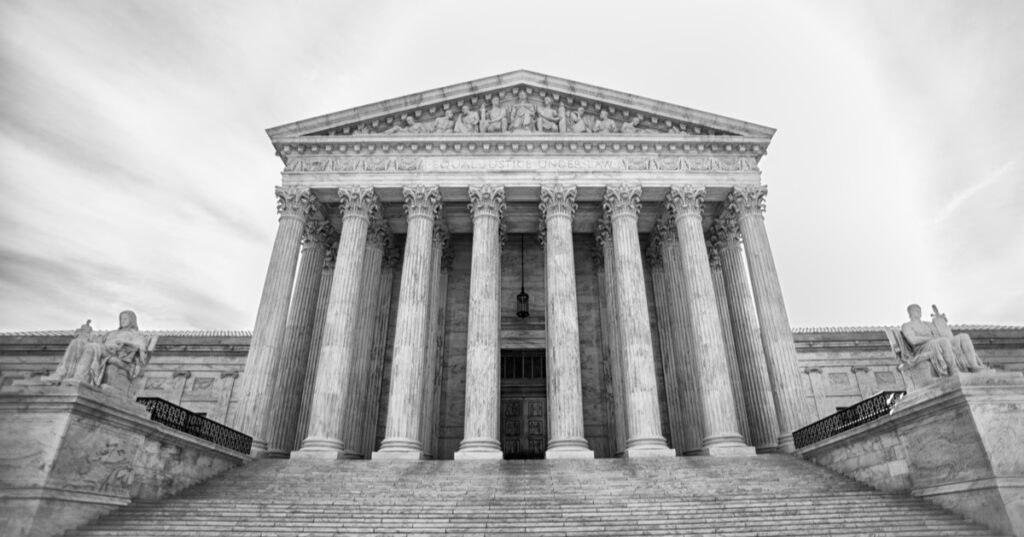The Supreme Court will hear arguments on November 5 about President Trump’s claimed authority to set and change tariffs under emergency powers, and the court has already extended argument time and moved the case onto an expedited track that could produce a decision before year’s end. The fight centers on whether the International Emergency Economic Powers Act of 1977 gives the president broad tariff powers or whether limits in Section 122 of the Trade Act of 1974 control, and the outcome will affect trade policy, manufacturing, and national economic strength.
The court’s decision to grant extra time for the Nov. 5 arguments signals this is not a routine dispute. Justices approved an enlargement that expands oral argument time to 80 minutes, reflecting the big stakes and complex statutory questions involved. That scheduling choice feeds expectations that the court sees a public interest in resolving the dispute quickly.
The combined cases named in the briefing list include Learning Resources, Inc. v. Trump and Trump v. V.O.S. Selections, and the extra time was divided so the solicitor general gets 40 minutes while private parties and a coalition of states share 20 minutes each. This split shapes the flow of the argument, concentrating the administration’s presentation while preserving time for challengers to address key legal points. The unsigned one-page order granting the enlargement underscores the court’s interest in a focused, thorough oral argument.
At the heart of the fight is the International Emergency Economic Powers Act of 1977, or IEEPA, which the administration has relied on to declare a national emergency and impose import surcharges. The administration argues IEEPA authorizes broad measures in an emergency, including changing tariffs to protect the U.S. economy, supply chains, and national security interests. Opponents counter that the statute was never meant to erase more specific trade-law constraints and that broad emergency powers should not be stretched to cover ordinary tariff policy.
Closely tied to IEEPA in the litigation is Section 122 of the Trade Act of 1974, a more explicit tariff statute that authorizes a temporary import surcharge under narrow conditions. Section 122 allows a temporary surcharge to address “fundamental international payments problems” or to prevent “an imminent and significant depreciation of the dollar in foreign exchange markets,” but it also caps such measures at 15 percent and limits them to 150 days. Those numerical limits are central to challengers’ arguments that Congress set clear boundaries for tariff use.
Challengers argue that Section 122’s explicit caps and short duration should inform how courts read IEEPA so that emergency authority cannot swallow the specific rules Congress intended. The states and private parties pressing the challenge see a logical rule of construction: where Congress has spoken directly to tariffs, those limits should control rather than a broad, open-ended emergency grant. The administration rejects that reading and insists the two statutes are “complementary” while legally separate routes to protect American interests.
The government has signaled it has fallback statutory tools should the court reject its expansive interpretation of IEEPA, but those alternatives are not identical. Treasury Secretary Scott Bessent acknowledged publicly that other authorities are “not as efficient, not as powerful,” which frames the administration’s preference for IEEPA as both practical and strategic. From a Republican perspective, the difference matters because stronger, more flexible tools have been used to counter unfair trade practices and to push back against persistent deficits harming domestic manufacturers and farmers.
President Trump has emphasized how vital he believes these tariff powers are to national strength and economic resilience, and his statements have been direct and forceful. “If these Tariffs ever went away, it would be a total disaster for the Country. It would make us financially weak, and we have to be strong,” he wrote, underscoring a view that tariffs are a tool to reverse long-term economic erosion. He also warned, “If allowed to stand, this Decision would literally destroy the United States of America,” making clear the administration sees the stakes in existential terms.
The president framed tariffs as a response to persistent trade imbalances and foreign barriers, arguing they protect manufacturers, farmers, and American jobs. “The U.S.A. will no longer tolerate enormous Trade Deficits and unfair Tariffs and Non Tariff Trade Barriers imposed by other Countries, friend or foe, that undermine our Manufacturers, Farmers, and everyone else,” he said, tying the legal fight to a broader economic and political agenda. He went on to assert, “For many years, Tariffs were allowed to be used against us by our uncaring and unwise Politicians. Now, with the help of the United States Supreme Court, we will use them to the benefit of our Nation, and Make America Rich, Strong, and Powerful Again!”



